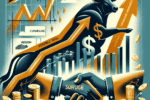San Francisco, California – The demand for silver from industrial sectors has been on the rise, particularly driven by the solar panel manufacturing industry. In 2023, there was an 11% increase in demand compared to the previous year, with forecasts predicting another 9% increase this year.
This surge in demand has been primarily attributed to the solar industry, which has shown a growing appetite for silver. While demand in this sector had been stable at around 2,800 metric tons per year for several years, it saw a sharp rise in 2022. Projections indicate that the demand from solar for silver in 2024 will reach 7,216 metric tons, contributing significantly to the forecasted total industrial demand of 22,111 metric tons.
The Silver Institute reports that photovoltaic panels alone will drive nearly one-third of all industrial demand for silver. This growth in demand is seen as promising for silver investors but concerning for manufacturers who rely on the metal for various applications.
A potential shortage in silver supply is looming, with implications already being felt in the market. The price of silver recently surpassed $30 per ounce for the first time in over a decade, indicating the impact of increasing demand.
In a significant development, Samsung unveiled a solid-state battery that utilizes silver as a core component. This innovation represents a major advancement in making electric vehicles more efficient, with promises of a 600-mile range, fast recharge times, lighter weight, extended lifespan, and reduced fire risk.
If electric vehicles adopt this technology and account for 20% of global automobile production, the annual demand for silver could reach 16,000 metric tons. This level of demand represents a considerable increase of 72% in total industrial demand, showcasing the potential impact of solid-state technology in various applications.
Overall, the current silver ecosystem may not be adequately prepared for the impending surge in demand, posing challenges for both investors and manufacturers alike. Higher prices will likely be necessary to make less profitable silver deposits economically viable for production, reflecting the growing importance of silver in today’s industrial landscape.










